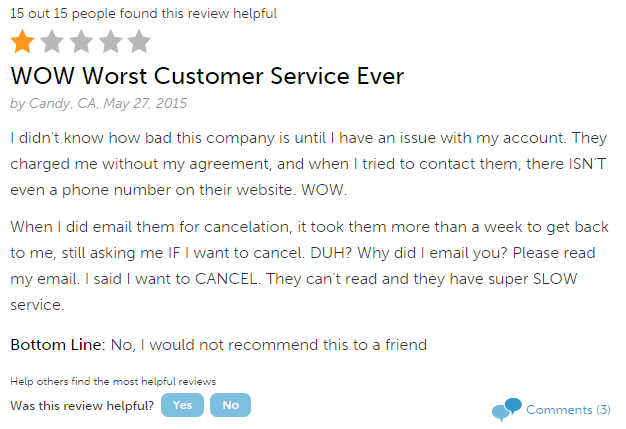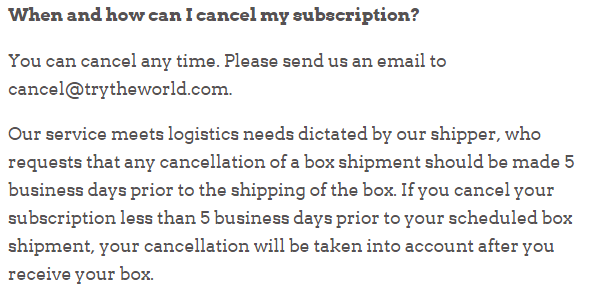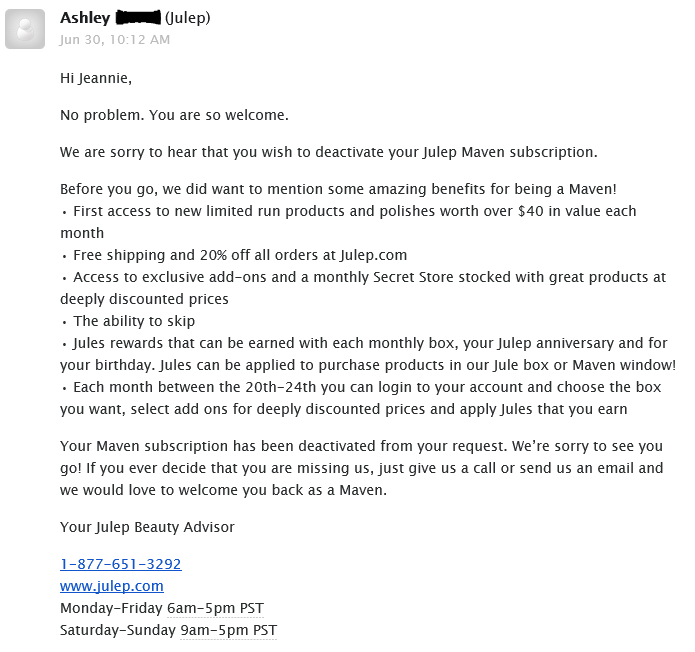There is a booming industry around subscription services right now.
Birchbox is possibly the best known and one of the most successful business models.

But the list of subscription products is a long one now. You can order monthly boxes of video games, curated outfits, beer, razors, or anything else you desire. In today’s hectic but “I want the new thing” culture, this model seems to fill a need. The companies promote a concept of trying things out, and sometimes only keeping what you like.
But the idea of making it difficult for customers to cancel a subscription service as a business strategy?
That is not a winning strategy for anyone.
I like to try things. I like to see what the experience is like. So I signed up for two such services in the last few months. I canceled both of them recently, and the way my cancelation request was handled is a tale of two very different experiences, and shows how saying one thing and doing another is really not a great way to treat customers.

1. Try The World
This service promises food from the around the globe, along with recipes and suggestions for how to use these unique delectables. We tried it, found we weren’t using the exotic foods much with our two kids, and decided to cancel.
I canceled somewhere around April 25th. I emailed the “[email protected]” email address and thought it was done. Here is what they say in their FAQ section:
(To be clear, I canceled well before the shipment logistics were an issue.)
Well, their model is to make it difficult.
They sent instructions about when I could call them. Why should a customer need to call anyone to cancel? I was very clear about why – it’s not you, it’s us. And the “cancel anytime” seems like hooey in this regard, too.
To make it more complex, the “instructions” about when to call came from a totally separate email address. Instead of receiving a reply from “[email protected]” the reply came from a cryptic email address.
The packaging, the food and the recipes were really lovely. The box is beautifully packed and the experience is nice. Some delicate items were broken by the time they arrived, but for the most part we had good experiences with the 2 boxes we received. I would have said really nice things to people who may order. People with fewer baseball and piano appointments around dinner time, perhaps!
But I’m not sure what I did with said instructions. I remember rolling my eyes and thinking “I don’t have time for this.” But I had canceled, clearly.
So imagine my surprise when we received another box in June. I opened the package thinking maybe it was a “please stay with us” ploy. But, no, it was just a regularly billed box.
I emailed again, saying, no, I canceled and didn’t order this box. I was informed I “didn’t complete the cancelation process” on my end. Anyone can see this is total and utter bull pucky. In fact, many reviews online show this. Customers aren’t stupid. We know you’re trying to make it painful to cancel.
I was also told I’d be charged for the latest box unless I sent it back. On my dime.
I gave up. I wrote back and thanked them for the blog inspiration!
2. Julep
I tried Julep because I was intrigued by how the founder reaches out to her customers, including them in choosing what products to roll out next and how to name their nail polish colors. The box experience each month was fun. Good products, plus a few unique candies tossed in for a little bit of surprise and delight.
I canceled Julep via email, too. I explained I just didn’t use beauty products that quickly (some days makeup is the last thing on my mind!) but I liked all of their products.
This is the considerate email I received in return:
No muss, no fuss.
I wrote an email back thanking her for handling this so quickly, to which she replied personally again and said you’re welcome! If I feel like I could keep up, I’d have no problem signing up again as a customer with Julep, who I’ll also gladly recommend to others.
I realize the company has goals of retaining as many customers as possible. But there are better ways to do this.
Forcing your customers through painful cancellation policies is so clearly NOT about your customers. Making it easy, and actually about them, could lead to future referrals and returns from customers who leave you. Making it painful leads to angry former customers who will share their disappointment with the world.
So what’s the true cost of making cancellation painful for your customers?
Image credits: dingopup, Kurayba via Creative Commons license








Painful cancellation is a hallmark of Comcast’s business strategy (and corporate culture), where they use incentivized “customer retention specialists” to dig in their heels and do everything possible to keep defection-minded customers from leaving. When their policies and protocols went viral as a result of a customer recording his service cancellation call with one of their retention specialists, this contributed to Comcast having to withdraw its acquisition bid for Time Warner Cable: http://customerthink.com/how-customer-centricity-creates-bondingand-rejection-and-anger-yes-boys-and-girls-culture-matters/